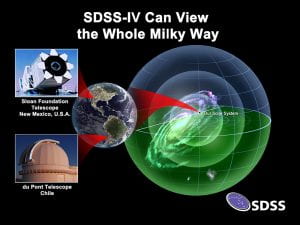
APOGEE-2 extends the sky coverage of the SDSS by using telescopes at both Apache Point Observatory (APOGEE-2N) and Las Campanas Observatory in Chile (APOGEE-2S). Using telescopes in both hemispheres means that APOGEE-2 is able to view the entire Milky Way. Image credit: Dana Berry / SkyWorks Digital Inc. and the SDSS collaboration.
Carl Sagan, a famous scientist, said you are made up of “star stuff.” And before you think he was talking about your prowess on the basketball court, or your super knowledge of Minecraft, know that Sagan was making a point about how deeply connected we are as humans to the whole of the universe. Specifically, the building blocks of all life, or what’s sometimes referred to as the CHNOPS elements—carbon, hydrogen, nitrogen, oxygen, phosphorous, and sulfur—are all made in the stars and also are found in our bodies. The nitrogen in your DNA, or the calcium in your bones, or the phosphorous in your cells all can be traced back to “star stuff.”
You may never have heard of Carl Sagan, but he had a popular television series in the 1980’s called Cosmos back in the days when families would gather around their television set and watch together. In those days, people believed science could help us figure out better ways to live here on Earth, and Sagan’s communication skills helped us understand some complex ideas about our universe. Public confidence in science today, according to the Pew Research Institute, is being altered around partisan divisions. Let’s face it; most of us would have a difficult time coming up with the names of scientists that we watch or listen to regularly on our devices.
So you may have missed the news that recently Sagan’s star stuff information added another chapter. Sten Hasselquist, an astronomer at New Mexico State University (NMSU), along with other researchers, have measured the CHNOPS elements among stars across the Milky Way. It’s the first time so many stars have been analyzed for these elements.
“I am interested in understanding how our Galaxy formed and evolved by analyzing the chemical abundance patterns of stellar populations,” Hasselquist states on his NMSU faculty directory page. He primarily uses data from the Apache Point Observatory Galactic Evolution Experiment (APOGEE). The APOGEE uses spectroscopy; it collects light in the near-infrared part of the electromagnetic spectrum and disperses it revealing the signatures of the elements in the atmospheres of stars. We know now that the atoms in our body are made from ancient stars, so Sagan’s “star stuff” ideas were spot on. Ashley King, a planetary scientist explains this process on London’s National History Museum website as “galactic chemical evolution.”
Science once again helps us understand who we are and where we fit in this vast Cosmos. Yet, who will tell the stories of these atoms’ journey? And who will listen if we lose interest or faith in the process of discovery and how it can help us make sense of our own journeys? Learning how to communicate science effectively is more important than ever. I invite you to come to the RFSC Writing Center to practice this key skill. Hope to see you soon!
References
Funk, C., Kennedy, B., & Johnson, C. (2020, May 21). Trust in medical scientists has grown in US, but mainly among democrats. Pew Research Center. pewresearch.org/science/2020
Hasselquist, S. (n.d.). New Mexico State University Faculty Directory. astronomy/nmsu.edu/directory/name/sten-hasselquist
Lotzof, K. (n.d.). Are we really made of stardust? Natural History Museum. www.nhm.ac.uk/discover/are-we-really-made-of-stardust.html
Sagan, C. (1973). The cosmic connection: an extraterrestrial perspective. Cambridge University Press. Cambridge, UK.
